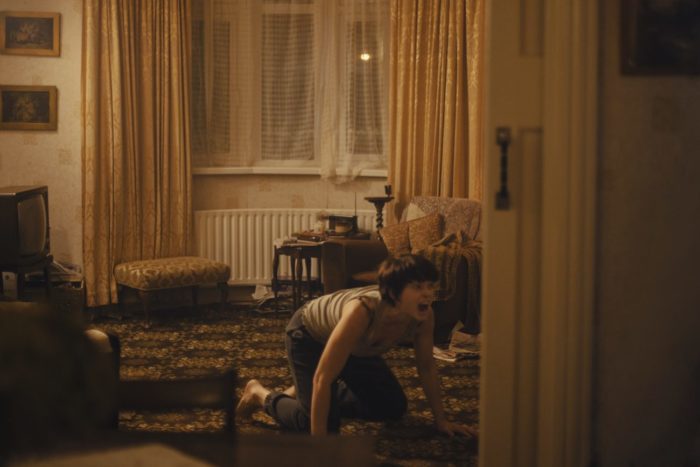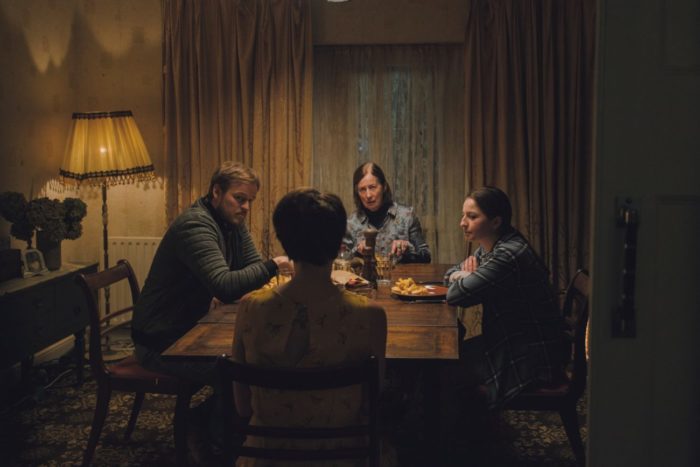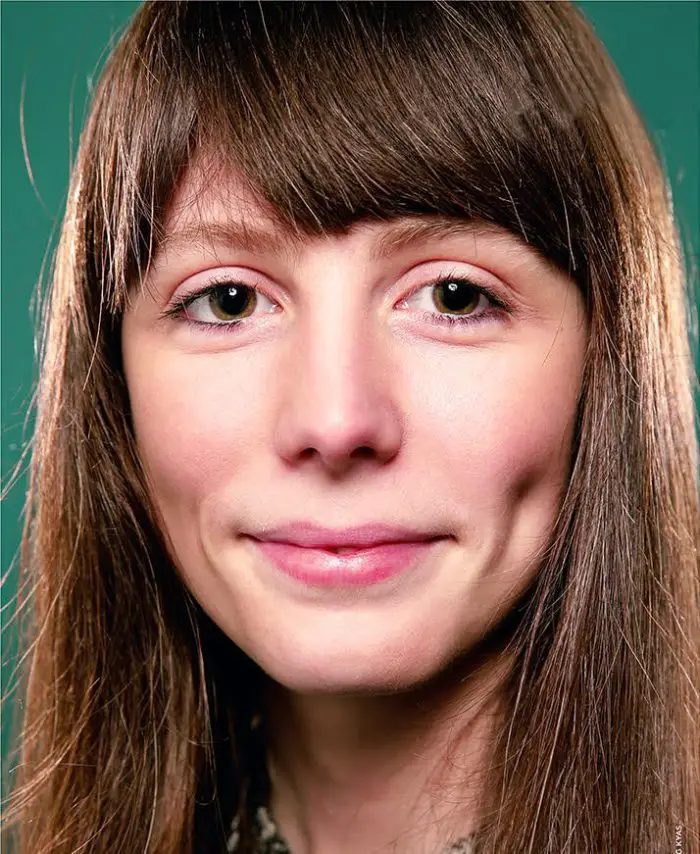I don’t mind saying, again, that this recent discovery of You Are Not My Mother is my favorite film of the year so far, and certainly the stand-out offering at the recent Glasgow FrightFest. It’s the story of teenage Char (Hazel Doupe) whose family is held in suspicion by those living nearby, and whose mother Angela (Carolyn Bracken) starts to act oddly following a brief absence. Then Granny (Ingrid Craigie) explains what to do about it. The blend of gritty domestic drama with folklore-based horror impressed me a great deal, and it was therefore a treat to spend a little time talking to debut director Kate Dolan recently.
The performances were striking, especially from the central three, none of whom are known from the horror genre. I started by asking Kate how she went about casting the family members. “We all kind of knew it would hinge on who was going to play Char,” Kate told me. “In the script, she was in every single scene, almost; and being a young person, it was clear this required a really strong actor, to be on the screen so much. As well as that, she’s a character with a lot going on internally: she doesn’t have much dialogue, doesn’t say much about how she’s feeling, and it all has to come from her look and how she reacts to other people. I had seen Hazel in a few things, in particular a short film called Ciúnas (Silence), which was a really heartbreaking performance in which she had barely any dialogue, but her face told so much. I saw that and knew that she would be able to carry the film, so we had a call, she read the script, and we got along really well. She loves horror and she had kind of a Wicca vibe, she was drawn to the material…and so she was the first person we cast, that was March 2020.
“Then because of COVID, we were pushed to start shooting at the end of that year, in November; so we were really lucky that Hazel was with us early, part of the team, so me and her could go over the role and do a lot of chatting. I sent her books and all sorts of things. Then we were able to start casting from her: people who would have good chemistry with her. Most of them were people I was sent tapes by different actors and gradually I whittled it down and we did a chemistry test with Hazel and Carolyn, who plays her mother Angela. Then she, basically, was so amazing and strong; had such good chemistry with Hazel that it really worked. We were very lucky, and for another reason too, to do with COVID: not a lot of other production were running, and so people were available to use. I mean ours was a fairly low-budget, no-frills, DIY affair, and bigger productions couldn’t carry on so easily. But honestly, we were very lucky with the cast, and they were all such nice people to work with.”

Focusing on the character of Angela, now, I referred to the feral moments in her performance and asked Kate what direction she had given Carolyn Bracken for those. “Obviously the film is quite inspired by Irish folklore,” Kate said, “so those aspects of the performance came from the stories I had read about fairy folk and other malevolent beings. They’re kind of representations of the id and primal urges that we have; in the stories, they love dancing and eating, just the pleasures of the world. They haven’t got a lot of morality.” Having grown up in Ireland myself, I was also familiar with stories of the fairies (known as the sidhe) and remembered them being a mischievous breed. “Yes! Carolyn took a lot of inspiration from that, and really leaned into being quite primal and animalistic in a way, the things that make us a little bit inhuman. Also, we had a great track for her; I sent her some of what the composer had made, which put her into the right headspace and prepared her for the part, a good tonal part. I sent her some dance sequences from films I love too; not dance, really, but you know that subway scene in Possession (1981); and the primal dances in the recent Suspiria. She built it from that, and we worked together on the movements and what she might do; it was really collaborative, a nice process. She’s not afraid to let herself go, which is great to work with as a director.”
Kate had mentioned the music there, which led me to another question. The score had added to the tension beautifully, so I asked Kate what brief she gave the composer, Die Hexen. “She is a very interesting person,” said Kate. “She’s a performance artist too, and a sound designer and has a lot of other talents, apart from composing music; and she brought all that into designing our soundtrack. I was so happy for her to run away with ideas and experiment with non-traditional instruments; like crystals that would make certain sounds and ancient instruments that hadn’t been used to make traditional Irish music in hundreds of years. Very much rooted that it still felt Irish, still felt traditional and with a strong folklore hint to it.”

My kid had watched You Are Not My Mother with me the night before when I was preparing, and they raised a question about the essential story of the film. The concept of changelings isn’t original as such (it even features in My Little Pony, they said!), but then there’s an urban setting, which seems like a unique contrast with the mythical notion of changelings: Nathan wanted to know how Kate came to combine those two together into this story. “I get what you mean,” Kate said. “In Irish culture, our folklore and old paganism still permeates into modern society; like on Halloween night, we still light bonfires. So there is still superstition, which we really feel even today in modern Ireland. I grew up just outside Dublin city and the stories we heard about all felt very rural, but there was as much superstition in urban areas. My grandmother was pretty witchy, for example. So it still felt like part of my culture, wherever we lived, but there weren’t stories in a city setting. So I wanted to take the old mythology but put it into my world. And I think a ‘cabin in the woods’ type story where people go to a rural setting and then bad things happen is something we’ve seen a lot, but it can be even scarier to be isolated when you’re surrounded by lots of people in a housing estate. So, that to me, was really interesting.”
Now that Kate had expanded on the mythology side of things, I had to ask about the directions my mind had been wandering in relation to the sidhe. I had wondered whether bits of the back story had been connected to their motivations: the fact that Char had no father in her life, for example. Do these pieces fit together, or is it all just a fluke? “Oh a full family history is written down somewhere on my laptop,” Kate confirmed. “When we were writing the script we had to decide how much to explain and how much to not, but my favorite kind of films are the ones that don’t explain everything so that when you leave, you can talk to your friends about it: ‘what did that mean?’ and ‘why did that happen?’ Loads of aspects of the film are related to the place where they live: it’s some kind of sacred ground and now the housing estates have been built over it: so there’s always a friction between the other world and this, which is these estates that they live in. The idea that the river is the part where the worlds connect, and that’s where Suzanne’s mother died, and in Ireland, there are lots of stories about how different people are affected by creatures who lure them to their doom, and I wanted to include as many facets of that as I could. Discretely, too.”

Something about the inner city vibe had reminded me of Candyman and so I asked Kate what films had influenced her. “Well Candyman is definitely one; it’s one of my favorite movies,” Kate confirmed. “I love the way it took legends into an urban setting and it was obviously a big reference for us—especially as they end with a bonfire. We knew we’d end our film with a bonfire, because it’s set on Halloween night, and a big part of Irish culture is the bonfire on Halloween, and we drew many parallels. Then there’s Rosemary’s Baby: that film (despite who directed it) is still a favorite of mine, and it takes the POV of one character and keeps you in that from beginning to end. The audience feels as if they are Rosemary and everything is through her eyes: that was a reference for us with Char because the audience feels the film through her and rarely breaks from that except for a couple of moments. And then a film like The Exorcist was a reference too. It’s always remembered for its climax, with all that vomiting; but when you watch The Exorcist, the first half, or maybe more, not much happens. Instead, they get you to feel that this is a real mother and daughter, and they bring in the supernatural aspects very minimally. In prep, me and the editor rewatched that. To me, one of the scariest bits of The Exorcist is when she walks in and her mother is having friends over, and the daughter just wets herself; it’s so odd and disturbing, but not scary. Also, I love Japanese and Korean cinema. Their folklore is very similar to Irish folklore in some ways. I really love the way they pace their films, tonally; films like Pulse or the original Ring.” [There is no other Ring, I declared, and Kate agreed.] “Especially Pulse: there are so many eerie moments that aren’t necessarily explained but are just unsettling. That definitely influenced me in putting the film together.”
I wished Kate well for the UK premiere, due to take place a couple of days later in Glasgow. “Yes, FrightFest! It’s exciting!” she grinned. “I love genre film festivals. Obviously, I’m a big horror fan so I’m just excited to get to watch other films this weekend.”
Signature Entertainment presents You Are Not My Mother in UK Cinemas and on Digital April 8th (Wildcard release in Irish Cinemas 4 March).


